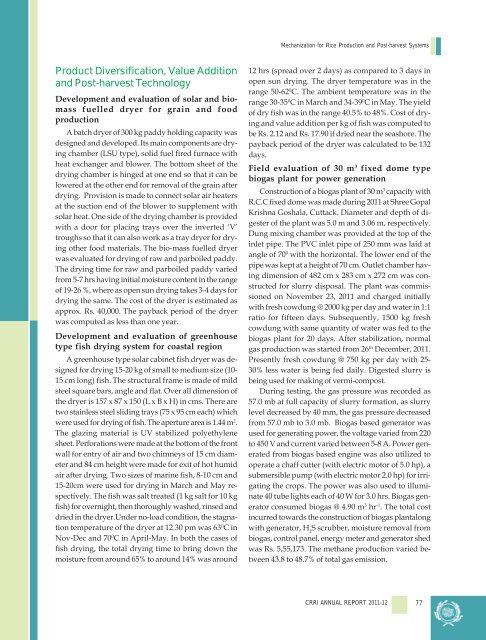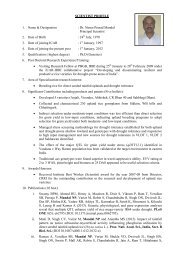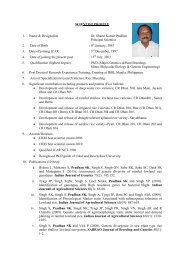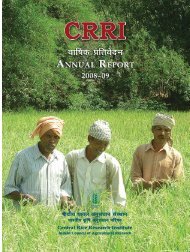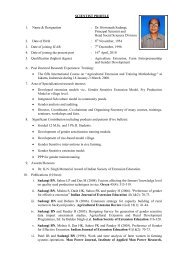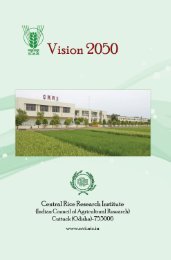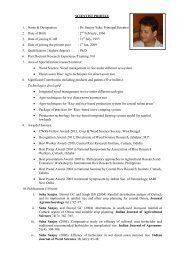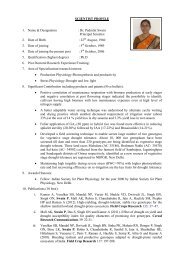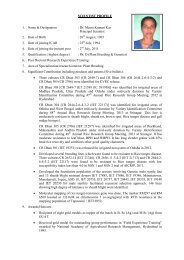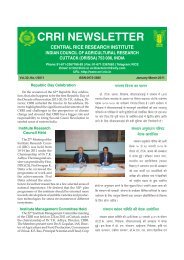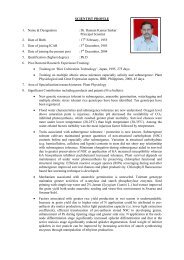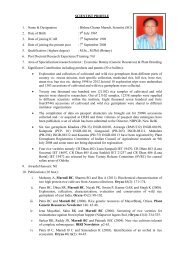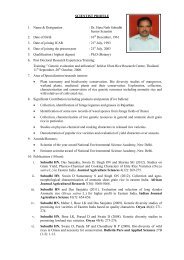Central Rice Research Institute Annual report...2011-12
Central Rice Research Institute Annual report...2011-12
Central Rice Research Institute Annual report...2011-12
You also want an ePaper? Increase the reach of your titles
YUMPU automatically turns print PDFs into web optimized ePapers that Google loves.
Mechanization for <strong>Rice</strong> Production and Post-harvest Systems<br />
Product Diversification, Value Addition<br />
and Post-harvest Technology<br />
Development and evaluation of solar and biomass<br />
fuelled dryer for grain and food<br />
production<br />
A batch dryer of 300 kg paddy holding capacity was<br />
designed and developed. Its main components are drying<br />
chamber (LSU type), solid fuel fired furnace with<br />
heat exchanger and blower. The bottom sheet of the<br />
drying chamber is hinged at one end so that it can be<br />
lowered at the other end for removal of the grain after<br />
drying. Provision is made to connect solar air heaters<br />
at the suction end of the blower to supplement with<br />
solar heat. One side of the drying chamber is provided<br />
with a door for placing trays over the inverted ‘V’<br />
troughs so that it can also work as a tray dryer for drying<br />
other food materials. The bio-mass fuelled dryer<br />
was evaluated for drying of raw and parboiled paddy.<br />
The drying time for raw and parboiled paddy varied<br />
from 5-7 hrs having initial moisture content in the range<br />
of 19-26 %, where as open sun drying takes 3-4 days for<br />
drying the same. The cost of the dryer is estimated as<br />
approx. Rs. 40,000. The payback period of the dryer<br />
was computed as less than one year.<br />
Development and evaluation of greenhouse<br />
type fish drying system for coastal region<br />
A greenhouse type solar cabinet fish dryer was designed<br />
for drying 15-20 kg of small to medium size (10-<br />
15 cm long) fish. The structural frame is made of mild<br />
steel square bars, angle and flat. Over all dimension of<br />
the dryer is 157 x 87 x 150 (L x B x H) in cms. There are<br />
two stainless steel sliding trays (75 x 95 cm each) which<br />
were used for drying of fish. The aperture area is 1.44 m 2 .<br />
The glazing material is UV stabilized polyethylene<br />
sheet. Perforations were made at the bottom of the front<br />
wall for entry of air and two chimneys of 15 cm diameter<br />
and 84 cm height were made for exit of hot humid<br />
air after drying. Two sizes of marine fish, 8-10 cm and<br />
15-20cm were used for drying in March and May respectively.<br />
The fish was salt treated (1 kg salt for 10 kg<br />
fish) for overnight, then thoroughly washed, rinsed and<br />
dried in the dryer.Under no-load condition, the stagnation<br />
temperature of the dryer at <strong>12</strong>.30 pm was 63 0 C in<br />
Nov-Dec and 70 0 C in April-May. In both the cases of<br />
fish drying, the total drying time to bring down the<br />
moisture from around 65% to around 14% was around<br />
<strong>12</strong> hrs (spread over 2 days) as compared to 3 days in<br />
open sun drying. The dryer temperature was in the<br />
range 50-62 0 C. The ambient temperature was in the<br />
range 30-35 0 C in March and 34-39 0 C in May. The yield<br />
of dry fish was in the range 40.5% to 48%. Cost of drying<br />
and value addition per kg of fish was computed to<br />
be Rs. 2.<strong>12</strong> and Rs. 17.90 if dried near the seashore. The<br />
payback period of the dryer was calculated to be 132<br />
days.<br />
Field evaluation of 30 m 3 fixed dome type<br />
biogas plant for power generation<br />
Construction of a biogas plant of 30 m 3 capacity with<br />
R.C.C fixed dome was made during 2011 at Shree Gopal<br />
Krishna Goshala, Cuttack. Diameter and depth of digester<br />
of the plant was 5.0 m and 3.06 m, respectively.<br />
Dung mixing chamber was provided at the top of the<br />
inlet pipe. The PVC inlet pipe of 250 mm was laid at<br />
angle of 70 0 with the horizontal. The lower end of the<br />
pipe was kept at a height of 70 cm. Outlet chamber having<br />
dimension of 482 cm x 283 cm x 272 cm was constructed<br />
for slurry disposal. The plant was commissioned<br />
on November 23, 2011 and charged initially<br />
with fresh cowdung @ 2000 kg per day and water in 1:1<br />
ratio for fifteen days. Subsequently, 1500 kg fresh<br />
cowdung with same quantity of water was fed to the<br />
biogas plant for 20 days. After stabilization, normal<br />
gas production was started from 26 th December, 2011.<br />
Presently fresh cowdung @ 750 kg per day with 25-<br />
30% less water is being fed daily. Digested slurry is<br />
being used for making of vermi-compost.<br />
During testing, the gas pressure was recorded as<br />
57.0 mb at full capacity of slurry formation, as slurry<br />
level decreased by 40 mm, the gas pressure decreased<br />
from 57.0 mb to 3.0 mb. Biogas based generator was<br />
used for generating power, the voltage varied from 220<br />
to 450 V and current varied between 5-8 A. Power generated<br />
from biogas based engine was also utilized to<br />
operate a chaff cutter (with electric motor of 5.0 hp), a<br />
submersible pump (with electric motor 2.0 hp) for irrigating<br />
the crops. The power was also used to illuminate<br />
40 tube lights each of 40 W for 3.0 hrs. Biogas generator<br />
consumed biogas @ 4.90 m 3 hr -1 . The total cost<br />
incurred towards the construction of biogas plantalong<br />
with generator, H 2<br />
S scrubber, moisture removal from<br />
biogas, control panel, energy meter and generator shed<br />
was Rs. 5,55,173. The methane production varied between<br />
43.8 to 48.7% of total gas emission.<br />
CRRI ANNUAL REPORT 2011-<strong>12</strong><br />
77


